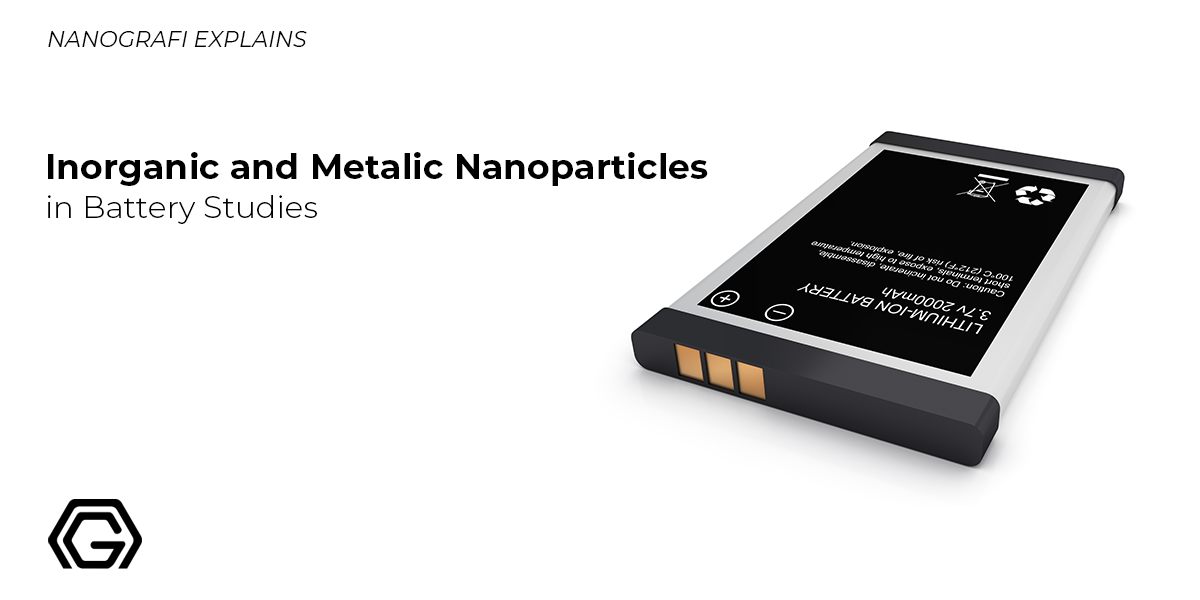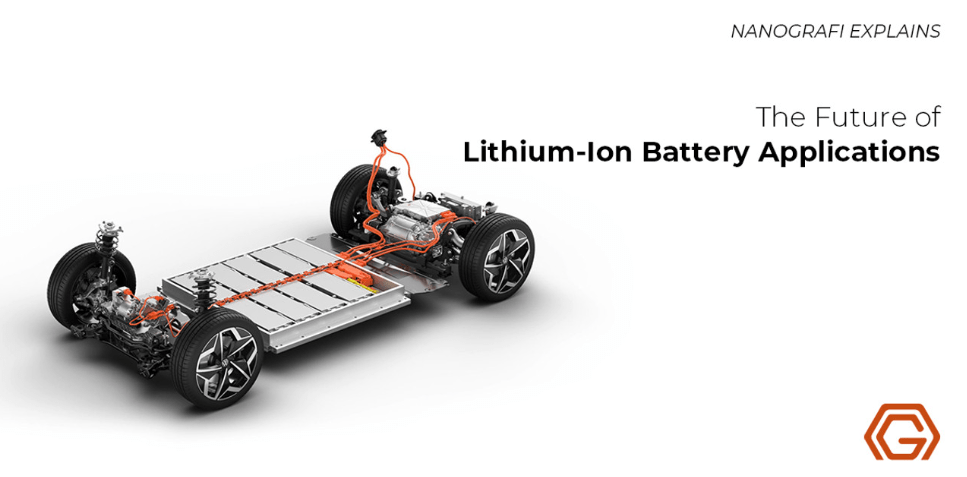Inorganic and Metalic Nanoparticles in Battery Studies
The advancement of battery technology is pivotal in the context of modern energy demands, particularly with the increasing shift towards renewable energy sources and electric vehicles. Among the various strategies employed to enhance battery performance, the use of inorganic and metallic nanoparticles has emerged as a significant area of research.
These nanoparticles offer unique properties that can improve the efficiency, capacity, and longevity of batteries. This article provides an in-depth exploration of the use of inorganic and metallic nanoparticles in battery studies, highlighting their roles, benefits, and the challenges associated with their integration. From anodes and cathodes to electrolytes and separators, Nanografi offes innovative solutions to improve battery performance and extend battery life. Visit Nanografi's website now.
Introduction
In recent years, the integration of inorganic nanoparticles has catalyzed substantial advancements in battery technology. These nanoparticles exhibit unique chemical and physical properties that can be meticulously tailored by manipulating their size, shape, and composition. The incorporation of inorganic nanoparticles into these systems has led to significant enhancements in performance, durability, and safety, facilitating the development of next-generation energy storage solutions.
Inorganic Nanoparticles in Battery Technology
Inorganic nanoparticles have garnered considerable attention due to their distinctive chemical and physical properties, which can be finely tuned by controlling their size, shape, and composition. These nanoparticles are utilized in various types of batteries, including lithium-ion, sodium-ion, and solid-state batteries.
Lithium-Ion Batteries
Inorganic nanoparticles have emerged as pivotal components in the development and enhancement of lithium-ion batteries (LIBs), offering significant improvements in performance, durability, and safety. These nanoparticles, owing to their unique physicochemical properties, have been integrated into various parts of LIBs, including electrodes and electrolytes.
Anode Materials
Inorganic nanoparticles are employed to improve the anode materials, which are crucial for the storage of lithium ions during charging. Traditional graphite anodes are increasingly being supplemented or replaced by nanoparticles to enhance their performance.
For example, Silicon (Si) nanoparticles have a high theoretical capacity for lithium storage (approximately 4200 mAh/g), which is ten times higher than that of graphite. The inclusion of Si nanoparticles in anodes significantly boosts the energy density of LIBs. However, Si nanoparticles tend to expand and contract during lithiation and delithiation, leading to structural degradation. This issue is mitigated by designing nanostructures such as Si nanowires or Si-graphene composites, which accommodate volume changes and maintain structural integrity.
Cathode Materials
The cathode is another critical component of LIBs, where inorganic nanoparticles have been used to improve performance. Lithium iron phosphate (LiFePO₄) nanoparticles are a prime example, known for their excellent thermal stability, safety, and long cycle life. Additionally, nanoparticles of lithium nickel manganese cobalt oxide (NMC) and lithium nickel cobalt aluminum oxide (NCA) have been developed to achieve higher energy densities and better rate capabilities. Moreover, zinc oxide (ZnO) and iron oxide (Fe₂O₃) nanoparticles have also been explored as potential cathode materials due to their high capacity and environmental friendliness.
Electrolytes
Solid-state electrolytes incorporating inorganic nanoparticles offer substantial benefits over traditional liquid electrolytes, such as higher thermal stability, reduced flammability, and prevention of leakage. For example, garnet-type nanoparticles like Li₇La₃Zr₂O₁₂ (LLZO) are used in solid electrolytes due to their high ionic conductivity and stability against lithium metal. The incorporation of LLZO nanoparticles in electrolytes facilitates the formation of a stable interface between the electrolyte and the electrodes, enhancing the overall efficiency and safety of LIBs.
Advanced Materials Involving Inorganic Nanoparticles
Graphene Oxide-Coated Nanoparticles: Graphene oxide (GO) is used to coat nanoparticles to improve their electrical conductivity and mechanical strength. GO-coated Si nanoparticles exhibit enhanced electrical connectivity and accommodate volume changes during cycling.
Metal Oxide Nanoparticles: Metal oxides such as titanium dioxide (TiO₂) and zinc oxide (ZnO) nanoparticles are employed in anodes and cathodes to improve specific capacity and cycling stability. TiO₂ nanoparticles are known for their structural stability and fast lithium-ion diffusion properties.
Carbon Nanotubes (CNTs): CNTs are used as conductive additives and structural reinforcements in both electrodes and electrolytes. Their high electrical conductivity and mechanical flexibility help maintain the structural integrity of electrodes and enhance the overall conductivity of the composite materials.
Do you know how Lithium-Ion Battery Applications will improve in the future? Learn now.
Sodium-Ion Batteries
Sodium-ion batteries (SIBs) are considered a promising alternative to LIBs, particularly for large-scale energy storage applications, due to the abundance and low cost of sodium. The use of inorganic nanoparticles in SIBs has led to significant advancements in their performance.
Improvement of Electrode Materials
Anode Materials
Hard carbon is commonly used as an anode material in SIBs, but it suffers from limited capacity and poor rate performance. Inorganic nanoparticles such as tin, antimony, and titanium dioxide have been investigated as alternative anode materials. Tin nanoparticles, for instance, exhibit high capacity but suffer from volume expansion. Composite materials combining tin with carbon or other conductive matrices have been developed to address these issues. Additionally, titanium aluminium carbide (Ti₃AlC₂) is being researched for its potential to offer both high capacity and structural stability.
- Carbonaceous Materials: Hard carbon is a common anode for sodium-ion batteries. Adding graphene nanoparticles boosts electronic conductivity and provides more active sites for sodium storage, improving performance and flexibility to handle volume changes.
- Metal Oxides:Nanoparticles of metal oxides like SnO2, TiO2, and Fe3O4 offer higher specific capacities. For instance, SnO2 nanoparticles, with a theoretical capacity of ~1378 mAh/g, enhance capacity and cycling stability by reducing mechanical stress through conversion and alloying reactions with sodium.
Cathode Materials
The development of efficient cathode materials is crucial for sodium-ion batteries (SIBs). Prussian blue analogs, transition metal oxides, and polyanionic compounds are key materials being explored. Inorganic nanoparticles like sodium manganese oxide (NaxMnO2) and sodium vanadium phosphate (NVP) demonstrate promising electrochemical performance, offering high capacity and good cycling stability.
- Sodium Transition Metal Oxides (NaxMO2): Transition metal oxides such as NaxCoO2, NaxFeO2, and NaxMnO2 benefit from nanoparticle engineering by reducing sodium ion diffusion paths, thus enhancing rate capability and overall performance. For example, NaxMnO2 nanoparticles provide high capacity and good rate capability due to their high surface area and efficient sodium ion diffusion pathways.
- Polyanionic Compounds: Nanostructured polyanionic compounds like Na3V2(PO4)3 offer high operating voltages and excellent structural stability. Nanoparticle forms of Na3V2(PO4)3 enhance ionic conductivity and rate capability, making them promising cathode materials for high-power applications.
Enhancement of Electrolyte Stability
Inorganic nanoparticles also play a crucial role in stabilizing the electrolyte in sodium-ion batteries. The addition of nanoparticles such as Al₂O₃, SiO₂, or ZrO₂ to the electrolyte helps form a stable solid electrolyte interphase (SEI) layer. This stabilization prevents side reactions and significantly improves the battery's cycling stability.
Solid-State Batteries
Solid-state batteries (SSBs) represent an advanced energy storage technology that addresses safety and performance limitations of traditional lithium-ion batteries. Inorganic nanoparticles play a critical role in enhancing the electrochemical properties, mechanical stability, and overall performance of both solid electrolytes and electrode materials.
Improvement of Solid Electrolytes
Inorganic nanoparticles can significantly improve the ionic conductivity and mechanical properties of solid electrolytes in solid-state batteries.
Ionic Conductivity Enhancement
- Sulfide-based Electrolytes: Nanoparticles of sulfide-based materials like Li10GeP2S12 (LGPS) demonstrate high ionic conductivities comparable to liquid electrolytes. LGPS nanoparticles reduce grain boundary resistance, thereby enhancing overall ionic conductivity.
- Oxide-based Electrolytes: Nanoparticles of oxide-based materials such as Li7La3Zr2O12 (LLZO) also improve ionic conductivity. LLZO nanoparticles reduce particle size, shortening diffusion pathways for lithium ions and significantly improving electrolyte performance.
Mechanical Stability
- Composite Electrolytes: Inorganic nanoparticles such as Al2O3, SiO2, and ZrO2 are often incorporated into solid electrolytes to enhance mechanical stability. These nanoparticles help to suppress dendrite growth by providing a robust matrix that prevents lithium dendrites from forming and causing short circuits.
Enhancement of Electrode Materials
Nanoparticles can be used to enhance the performance of both cathode and anode materials in solid-state batteries.
Cathode Materials
- Lithium Transition Metal Oxides: Nanoparticles of materials like LiCoO2, LiMn2O4, and LiFePO4 can improve the rate capability and cycling stability of cathodes. For example, LiFePO4 nanoparticles offer high theoretical capacity and excellent thermal stability. The nanoscale particles reduce the diffusion path for lithium ions, enhancing rate performance and cycling stability.
- High-voltage Cathodes: Nanostructuring high-voltage cathode materials such as LiNi0.5Mn1.5O4 (LNMO) can improve their electrochemical performance by increasing surface area and reducing diffusion distances for lithium ions.
Anode Materials
- Silicon-based Anodes: Silicon has a high theoretical capacity but suffers from significant volume expansion during cycling. Nanoparticles of silicon can mitigate these issues by accommodating the volume changes more effectively and enhancing the mechanical stability of the anode.
Metallic Nanoparticles in Battery Technology
Lithium-sulfur (Li-S) batteries are considered one of the most promising next-generation battery technologies due to their high theoretical energy density. Metallic nanoparticles have been employed to address key challenges in Li-S batteries.
Lithium-Sulfur Batteries
Lithium-air (Li-air) batteries have attracted attention due to their exceptionally high theoretical energy density. Metallic nanoparticles have been explored to improve the performance of Li-air batteries.
Catalysts
The oxygen reduction reaction (ORR) and oxygen evolution reaction (OER) are critical processes in Li-air batteries, and metallic nanoparticles serve as catalysts to enhance these reactions. Platinum, gold, and palladium nanoparticles are among the catalysts investigated for their high catalytic activity and stability. For example, platinum nanoparticles are highly effective for both the ORR and OER, leading to enhanced battery performance and efficiency. Gold nanoparticles enhance the ORR, resulting in higher efficiency and capacity due to their stability and high surface area. Palladium and copper nanoparticles also improve catalytic activity, contributing to better battery efficiency.
Electrode Materials
Metallic nanoparticles in electrode materials significantly impact Li-air battery performance. Carbon nanotubes decorated with manganese oxide or cobalt oxide nanoparticles improve conductivity and catalytic activity, leading to better battery performance. Manganese oxide boosts catalytic activity, resulting in higher discharge capacity, while cobalt oxide enhances ORR and OER, improving efficiency and cycle life. Hydroxyapatite is being researched for enhancing structural stability and electrochemical performance.
Conclusion
Inorganic nanoparticles play a crucial role in advancing battery technology across various types of batteries, including lithium-ion, sodium-ion, solid-state, lithium-sulfur, and lithium-air batteries. Their unique properties and versatility enable significant improvements in performance, durability, and safety, addressing key challenges and paving the way for next-generation energy storage solutions. By integrating these advanced materials, researchers and developers can achieve higher energy densities, better cycle stability, and enhanced overall efficiency, driving the evolution of battery technology forward.
To follow the latest developments and innovations related to nanotechnology, visit Blografi.
References
Bruce, P. G., Freunberger, S. A., Hardwick, L. J., & Tarascon, J. M. (2012). Li-O2 and Li-S batteries with high energy storage. Nature Materials, 11(1), 19-29. https://doi.org/10.1038/nmat3191
Goodenough, J. B., & Park, K. S. (2013). The Li-ion rechargeable battery: A perspective. Journal of the American Chemical Society, 135(4), 1167-1176. https://doi.org/10.1021/ja3091438
Manthiram, A., Fu, Y., Chung, S. H., Zu, C., & Su, Y. S. (2014). Rechargeable lithium-sulfur batteries. Chemical Reviews, 114(23), 11751-11787. https://doi.org/10.1021/cr500062v
The Future of Lithium-Ion Battery Applications - Nanografi Nano Technology. (n.d.). Retrieved June 14, 2024, from https://nanografi.com/blog/the-future-of-lithiumion-battery-applications/
Hu, M., Pang, X., & Zhou, Z. (2013). Recent progress in high-voltage lithium ion batteries. Journal of Power Sources, 237, 229-242. https://doi.org/10.1016/j.jpowsour.2013.03.024
Recent Posts
-
Turning Noise into Power: Energy Harvesting with Piezoelectric Nanogenerators
Ambient acoustic energy, once an untapped resource, is now being converted into sustainable electric …5th Mar 2025 -
Holey Super Graphene in Li-ion Batteries: Next Generation of Energy Storage
Holey Super Graphene (hG), also referred to as “holey graphene,” is redefining li-ion ba …7th Feb 2025 -
Future Communication with 5G Technology and Advanced Materials
5G technology opens the doors to a new era in communication with faster connection speeds, low laten …6th Feb 2025






